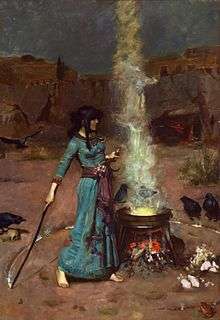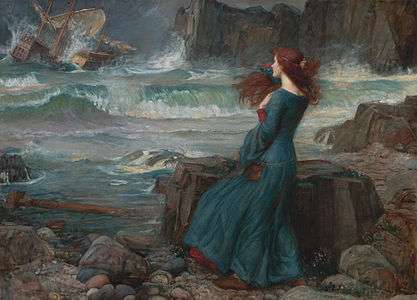The Magic Circle (Waterhouse painting)
The Magic Circle is the name of two 1886 oil paintings in the Pre-Raphaelite style by John William Waterhouse. The paintings depict a witch or sorceress using a wand to draw a fiery magic circle on the earth to create a ritual space for her ceremonial magic.
| The Magic Circle | |
|---|---|
| Artist | John William Waterhouse |
| Year | 1886 |
| Medium | Oil on canvas |
| Dimensions | 183 cm × 127 cm (72 in × 50 in) |
| Location | Tate Britain, London |


.jpg)
History
The larger version of The Magic Circle was shown at the Royal Academy in 1886,[1] and, after Consulting the Oracle and St. Eulalia, was Waterhouse's third exhibit with a supernatural theme in as many years.[2] The painting was well received at its exhibition, and was purchased for £650 the same year by the Tate Gallery, through the Chantrey Bequest.[3] The painting was extremely successful with the critics and public alike.
The smaller 1886 version of The Magic Circle measures 88 cm (34.6 in) high and 60 cm (23.6 in) wide. It is held by a private collector.[4] Waterhouse painted a c. 1886 study for The Magic Circle, 61.5 cm (24.2 in) high and 41.2 cm (16.2 in) wide, also held by a private collector.[5] He initially sketched the composition in a sepia pen and ink version in 1880–1881.[6]
The Magic Circle was recently on display at the National Gallery of Australia as part of the Love and Desire exhibition (December 2018 – April 2019).[7][8]
Description
In a style typical of Waterhouse, the main character is a lone, female figure, placed centrally on the canvas. The surrounding landscape is hazy, as though it is not quite real, and the background figures are only discernible on close inspection, deliberately ensuring the witch is the only image of importance.[1]
Waterhouse paid careful attention to the angles employed in this work, balancing the circle the figure is drawing around herself by the use of a triangle – her straight arm, extended by the straight stick, held out at 25 degrees to her erect body. The witch's power is emphasised by the determined face, by her exclusion of the ravens and frog – popular symbols representing magic – and by her command over the smoke pillar. Instead of billowing outwards or being affected by the wind, it remains in a straight line. A live snake ouroboros loops around the woman's neck.
The Magic Circle is similar in composition to Waterhouse's later 1916 painting, Miranda - The Tempest, which also portrays a woman associated with magic. Miranda wears a similar dress to the witch in The Magic Circle, and her face can also only be seen in profile. Unlike Frederick Sandys' portrayals of sorceresses, such as his 1864 Morgan le Fay and 1868 Medea, Waterhouse chose to make his witch's face intent and intriguing, as opposed to malevolent.
Themes
Miracles, magic and the power of prophecy are common themes in Waterhouse's art. More specifically, the notion of woman as enchantress is one that recurs in images such as Circe Offering the Cup to Ulysses (1891, Oldham Art Gallery) and Hylas and the Nymphs (1896, Manchester City Art Gallery). His oeuvre also includes a number of Middle Eastern subjects, in which he drew on the work of contemporary artists such as J. F. Lewis (1805–76) and Lawrence Alma-Tadema (1836–1912), rather than on actual experience. This is one of Waterhouse's earlier works, and reflects his fascination with the exotic.
The woman in this picture appears to be a witch or priestess, endowed with magic powers, possibly the power of prophecy. Her dress and general appearance is highly eclectic, and is derived from several sources: she has the swarthy complexion of a woman of middle-eastern origin; her hairstyle is like that of an early Anglo-Saxon; her dress is decorated with Persian or Greek warriors. In her left hand she holds a crescent-shaped sickle, linking her with the moon and Hecate. With the wand in her right hand she draws a protective magic circle round her. Outside the circle the landscape is bare and barren; a group of rooks or ravens and a frog – all symbols of evil and associated with witchcraft – are excluded. But within its confines are flowers and the woman herself, objects of beauty. The meaning of the picture is unclear, but its mystery and exoticism struck a chord with contemporary observers. When the picture was exhibited at the Royal Academy in 1886 the critic for the Magazine of Art wrote "Mr Waterhouse, in The Magic Circle, is still at his best – original in conception and pictorial in his results"
— quoted in Hobson, p. 37[1]
Theories
An article in the Pre-Raphaelite Society journal, The Review, has hypothesised that Waterhouse may have painted an image of his own face into The Magic Circle and that the image is only viewable at a specific required distance from the painting. The article also suggests that it may have been possible to achieve that distance by viewing the painting through reversed binoculars or opera glasses.[9] An accompanying documentary, Inside the mystery of JW Waterhouse's The Magic Circle, presents the visual argument.[10]
In contemporary culture
Harry Furniss created a number of parodies of The Magic Circle, including one in Punch showing actress Sarah Bernhardt tending a cauldron[11] and another in an exhibition The Magic Circle, or There's Nothing like a Lather by Soap-and-Waterhouse.[12]
Popular culture
The Magic Circle was part of the Harry Potter: A History of Magic exhibition at the British Library in 2017.
A reproduction of The Magic Circle is one of the paintings with an occult theme featuring in the set dressing of the TV series, The Chilling Adventures of Sabrina.[13][14]
References
- "John William Waterhouse The Magic Circle 1886". tate.org.uk. Retrieved 10 June 2019.
- Christie's. "John William Waterhouse, R.A. (1848-1917)". christies.com.
- "J. W. Waterhouse". johnwilliamwaterhouse.com. Archived from the original on 9 November 2009.
- [http://www.sothebys.com/en/auctions/ecatalogue/2013/british-irish-art-l13132/lot.13.esthl.html 2013 Sothebys sale
- 2009 Christies sale
- "Detail from JW Waterhouse Sketch for the Magic Circle".
- https://nga.gov.au/lovedesire/
- https://issuu.com/nationalgalleryofaustralia/docs/artonview_96
- "Jennifer Reeve-Williams & Mark Williams : The Face Inside the Circle: Optical Illusion or Subtle Magic in Waterhouse's Depiction of Sorcery".
- "Inside the mystery of JW Waterhouse's The Magic Circle, Jennifer & Mark Williams: Web documentary".
- "No. 450. Sarah B. in a New Piece. A big spooney scene". Archived from the original on 4 August 2016.
- https://web.archive.org/web/20161118150849/http://johnwilliamwaterhouse.com/articles/caricature-soap-and-waterhouse/
- "Real witches and pagans break down Netflix's Chilling Adventures of Sabrina".
- "Chilling Adventures of Sabrina , Season 1, Episode 3:".
Further reading
- Moyle, Franny (13 June 2009), "Pre-Raphaelite art: the paintings that obsessed the Victorians [print version: Sex and death: The paintings that obsessed the Victorians]", The Daily Telegraph (Review), pp. R2–R3.
- Simpson, Eileen (17 June 2009), "Pre-Raphaelites for a new generation: Letters, 17 June: Pre-Raphaelite revival", The Daily Telegraph.
- Dorment, Richard (29 June 2009), "Waterhouse: The modern Pre-Raphaelite, at the Royal Academy – review", The Daily Telegraph.
External links
| Wikimedia Commons has media related to The Magic Circle. |